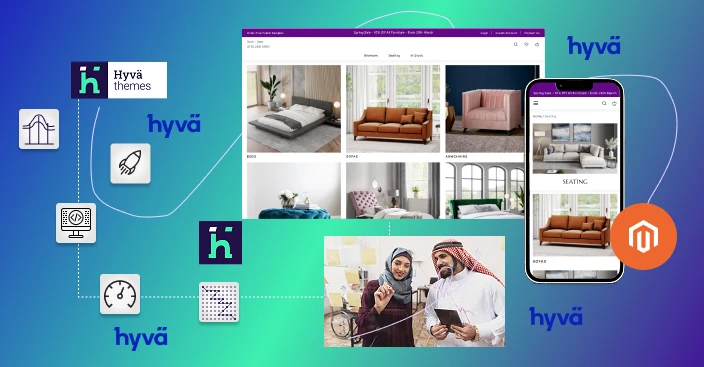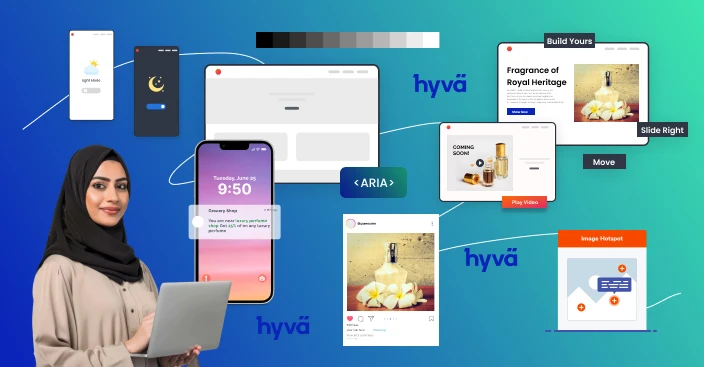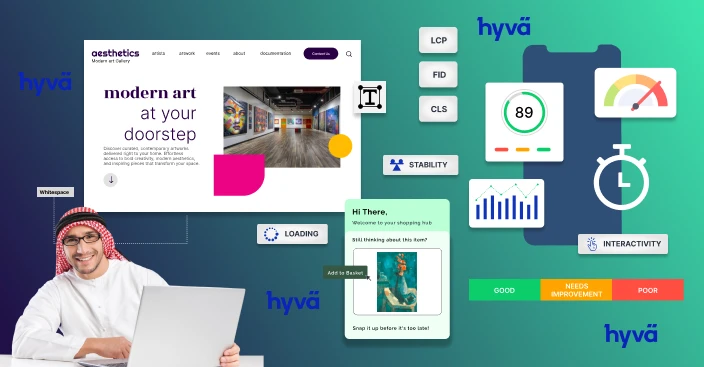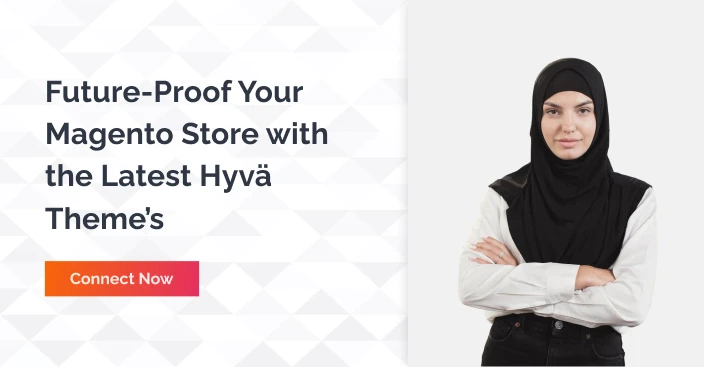Latest Hyvä Theme Trends to Elevate Your Magento UI/UX

Magento was the main engine behind difficult, feature-rich eCommerce platforms for a considerable amount of time. However, the default Magento frontend, Luma, started to show its age as commerce moved toward speed, simplicity, and seamless interactions.
It was overall slow and difficult for developers to make changes. Although headless solutions and Progressive Web Apps (PWAs) came as modern options, they also carried with them a number of downsides, including high costs, complex tech stacks, and steep learning curves.
This is where the need for Hyvä comes into play. Hyvä Themes took a unique approach to Magento development and front-end design, improving the entire process. Hyvä, built on Alpine.js and Tailwind CSS, is a lightweight, clean, and developer-friendly framework that speeds up, grows, and simplifies Magento businesses.
However, the narrative does not conclude here. As more developers and merchants use Hyvä, new design concepts, development approaches, and user experience breakthroughs arise.
In this blog, we explore the latest trends in Hyvä Theme development that are not just keeping Magento relevant in 2025 but propelling it into a new era of performance-first, experience-focused eCommerce.
The Evolution of Magento UI/UX in the Hyvä Era
Hyvä isn’t just a theme. It marks a major change in how Magento shops are made. It replaces legacy code, such as Knockout.js and RequireJS, with simple yet powerful technologies that improve speed and maintenance.
The result is a frontend that performs well in Google Lighthouse, has sub-second load times, and helps developers to design custom experiences without relying on outdated infrastructure.
With this simplest update comes a slew of UI/UX improvements. Developers are no longer constrained by Luma’s rigid layouts. Designers aren’t forced to make performance sacrifices for aesthetics.
Merchants don’t have to choose between beauty and speed. Hyvä enables it all, and now, new trends are shaping how we extend and enrich this experience even further.
A Design Language Shaped by Tailwind CSS
One of the most obvious changes in Hyvä-based UI/UX is the usage of Tailwind CSS as both a framework and a design language. The utility-first notion has had a major effect on designers and frontend teams, since it encourages the development of components using basic, reusable classes rather than pre-written blocks of code.
This modification allows for fine-grained control over all aspects of the design, including as spacing, color, font, shadows, and responsiveness, without the need for custom CSS. It also considerably accelerates the prototyping process.
Developers may now translate Figma layouts to Hyvä with near-perfect precision while still using Tailwind’s class system. This leads to fewer miscommunications between design and development teams and a more uniform visual experience for end users.
We’re seeing retailers use this to build unique UI patterns, floating add-to-cart buttons, dynamic promotional banners, sticky headers, and scroll-based interactions designed with efficiency in mind. Hyvä isn’t just catching up with the aesthetics of modern eCommerce; it’s becoming the benchmark.
Alpine.js: Powering Interactivity Without the Bloat
Hyvä’s integration with Alpine.js, a lightweight JavaScript framework that allows reactivity and interactivity without the cost of more complex frameworks like Vue or React, is another new feature. The way Magento stores and handles dynamic behaviours has shifted as a result of this alone.
It used to be required to go deeply into JavaScript files, use Knockout templates, or rely on third-party plugins in order to integrate features like collapsible menus, filters, modal windows, or tabs in Magento. This usually led to performance issues. In the Hyvä ecosystem, these interactions are handled with a few Alpine.js lines of code.
This results in more elegant, simple interactions that load quickly and feel native. Faster page transitions, more responsive input fields, and components that function reliably across devices all contribute to a more seamless user experience.
We’ve seen a rise in custom-built UI elements that appear smooth, modern, and frictionless while preserving accessibility and load speed as developers get more familiar with Alpine’s capabilities.
Giving A New Definition To The Checkout Experience
Perhaps one of the most critical—and long overdue- enhancements in Magento’s UI/UX journey is the checkout flow. Hyvä Checkout provides an alternative to the difficult default checkout procedure, which often resulted in significant abandonment rates.
Hyvä Checkout is built with modularity at its heart, allowing you to develop checkout pages that are matched to a brand’s tone and consumer behaviour.
Clear layouts, autocomplete suggestions, intuitive address inputs, and fewer clicks make the process more conversational. Nowadays, reducing friction and building trust are more important than just collecting data.
Hyvä Checkout is used by merchants to incorporate mobile-first payment buttons, progress indicators, and real-time shipping calculations.
The whole flow seems like an innovative app rather than a classic online form, which is particularly important considering that so many transactions are now made on mobile devices. Hyvä Checkout is not only faster, but also smarter.

Designing for Performance and Core Web Vitals
Another interesting trend is Hyvä’s inbuilt support for Core Web Vitals optimization, which has become required for both search engine rankings and user happiness. With Google’s analytics focused on page speed, visual stability, and interaction, Hyvä helps Magento sites to perform in all three categories, frequently without the need for extensive optimisation work.
Many developers are implementing strategies like lazy loading pictures, preloading fonts, and postponing non-essential scripts, all of which are integrated into the Hyvä architecture. This guarantees that page information is available virtually right away, layouts do not vary while loading, and visitors can interact with the site without experiencing annoying delays.
These improvements in performance are not little adjustments; they significantly increase engagement, reduce bounce rates, and enhance brand recognition.
UI/UX designers are also paying more attention to performance-first design, which encourages reduced media assets, simplified animations, and legible typography. It’s about finding a balance between speed and appeal, not about denying the site its uniqueness. And Hyvä makes that equilibrium possible.
The Rise of Design-Driven Development
An emerging trend with long-term implications is the integration between design tools like Figma and Hyvä’s Tailwind framework. Designers can now build thorough mockups in Tailwind-based component libraries, which developers can subsequently implement almost identically in Hyvä.
This alignment encourages an organised design process, reduces design debt, and prevents misunderstandings. The day when design tokens, predefined settings for colour, typography, and spacing, can be shared across Figma and codebases to ensure visual consistency across all screen sizes and devices is getting closer.
Complete design frameworks for Hyvä-based projects have been created as a result of this expansion, enabling teams to expand their frontend work across several stores, regions, or brands without compromising performance or identity.
Creating inclusive and global experiences
Hyvä’s expanded support for internationalisation and RTL (Right-to-Left) language layouts has made it possible for Magento firms to better serve a wide range of clients. In the past, dealing with overrides and third-party scripts was necessary when developing a storefront for regions like the Middle East, where languages like Arabic and Hebrew were widely spoken.
Hyvä’s clear structure and Tailwind’s RTL support make this work much easier to manage. Whether it’s supporting multilingual product descriptions, currency switchers, or directionally accurate layouts, stores can now maintain a consistent and inclusive experience for users worldwide. The result is not just accessibility, it’s a globally respectful and conversion-oriented UI/UX framework.

Going Beyond Themes: Toward Composable Frontends
As composable commerce gets pace, there is an increasing interest in hybrid installations in which Hyvä is used for basic storefront conversations and paired with headless solutions for high-demand areas like as search, customisation, or content delivery.
In these cases, elements of the site may employ React-based modules or headless CMS-powered landing pages, while Hyvä handles product pages, carts, and checkout. This modular architecture offers flexibility and performance without the cost or complexity of going fully headless.
The key takeaway is that Hyvä doesn’t lock you into a monolith. It allows you to evolve incrementally, introducing headless components only when they truly add value.
Personalisation Meets Performance
Customers today want a customised experience. Relevance is now mandatory whether it’s for product recommendations, predictive search, or targeted information. Hyvä makes it possible to integrate these intelligent features without slowing down the frontend.
Merchants are embedding AI-driven engines like Clerk.io, Nosto, and even custom ChatGPT-based assistants into their Hyvä storefronts. What’s exciting is how these are being integrated natively using lightweight wrappers, without heavy dependencies or bloated third-party libraries.
This fusion of personalisation and performance creates a shopping journey that feels both smart and smooth. It’s no longer a tradeoff between intelligence and speed; you can have both.
Building Better B2B Interfaces
Hyvä is also becoming the go-to choice for B2B eCommerce development, a sector that has long struggled with outdated interfaces and rigid workflows. B2B customers want the same level of use as consumers, and Hyvä enables this.
Developers are designing attractive and efficient B2B experiences with Tailwind and Alpine, including bespoke dashboards, account management portals, quick order grids, and request-for-quote processes.
These interfaces are user-friendly, mobile-ready, and extremely customizable, changing what was formerly a difficult ordering procedure into a simple transaction.
Final Thoughts
What started as a lightweight frontend alternative has quickly evolved into the most exciting movement within the Magento ecosystem. Hyvä has changed the way we think about eCommerce UI/UX—not by complicating it, but by simplifying it.
From incredibly quick load speeds and stunning layouts to user-friendly design systems and modular checkouts, the present Hyvä theme trends have pushed Magento to new heights.
They imply a growing need for user-centred, fast, and flexible design as well as a shift away from legacy difficulties and toward a more imaginative and transparent future.
Hyvä should be carefully considered if you intend to upgrade an existing Magento shop or develop a new one in 2025. Since experience matters most in industry, Hyvä can assist you in providing one that is truly unforgettable, in addition to being good. Connect with a Hyvä theme development expert to ensure a seamless experience for your target customers.
FAQ
1. Why is Hyvä superior to the Luma theme that comes with Magento for Saudi Arabian businesses?
Hyvä uses contemporary frameworks like Alpine.js and Tailwind CSS in favour of antiquated Magento frontend technologies like Knockout.js and RequireJS. For Saudi companies, this translates into quicker websites, more seamless customer experiences, and lower bounce rates—all of which are essential for drawing in and keeping online customers in a market that prioritises mobile devices.
2. In what ways does Hyvä streamline the development process for Magento?
Hyvä significantly reduces the complexity of the frontend. It is constructed with clear, contemporary code, loads more quickly, and is simpler to modify. Because of this, it is perfect for developers creating successful Magento stores in Saudi Arabia without having to deal with the usual development overhead of headless PWAs like Luma.
3. Is Hyvä able to manage Arabic (RTL) layouts, headless components, and AI personalisation?
Yes. Hyvä is versatile and lightweight, making it easy to incorporate AI technologies like as Clerk.io, localised search engines, and even partially headless components. With built-in support for RTL languages and Tailwind’s RTL plugins, it’s ideal for Arabic shopfronts catering to Saudi clients.
4. How does Hyvä improve Core Web Vitals and SEO for Saudi eCommerce?
Hyvä is built for performance, using best practices like as lazy loading, preloaded fonts, and script deferral. These capabilities directly boost your Google Core Web Vitals, boost search engine rankings, and give faster, smoother browsing experiences in the Saudi market. To know more about it connect with our Hyvä experts.
5. Why should Saudi firms utilise Magneto IT Solutions for Hyvä Theme development?
Magneto IT Solutions is a trusted Magento development partner in Saudi Arabia, with over 14 years of expertise and 250+ completed projects. We are experts in Hyvä theme development, Adobe Commerce and Magento to ensure a great web experience for your end-users.




